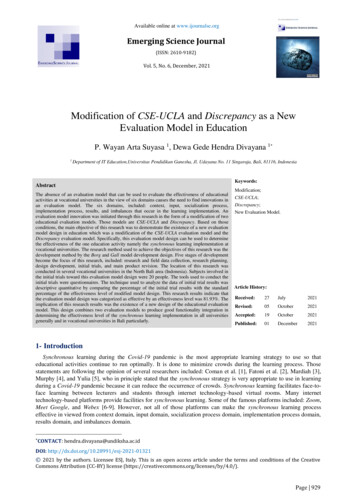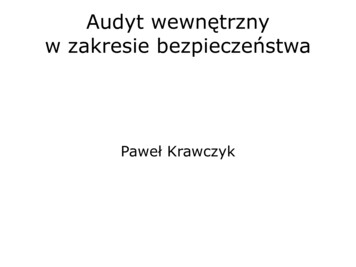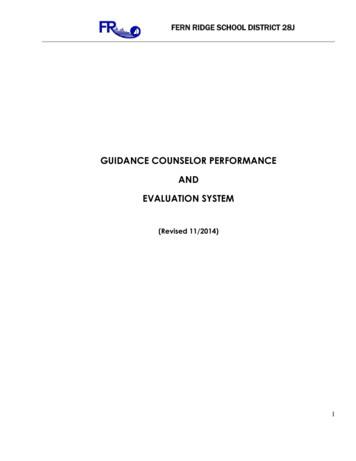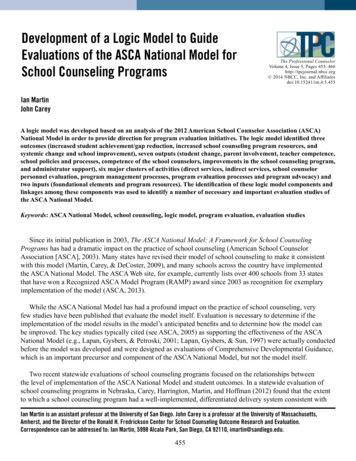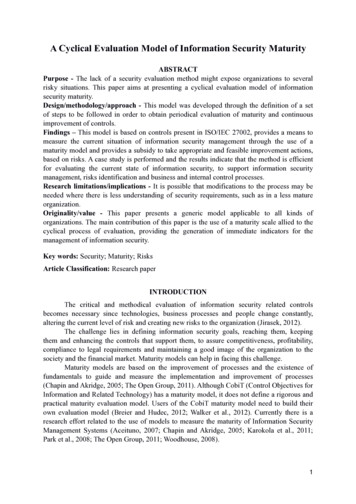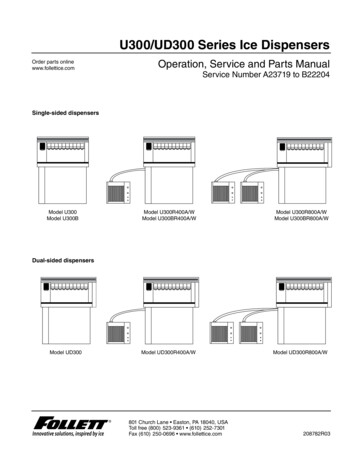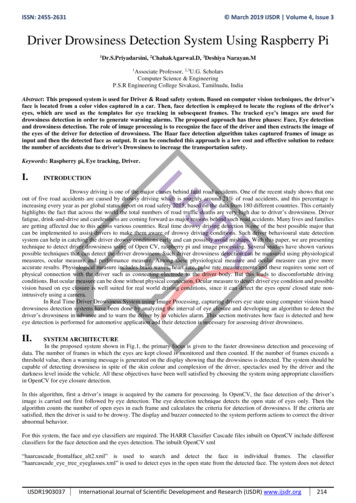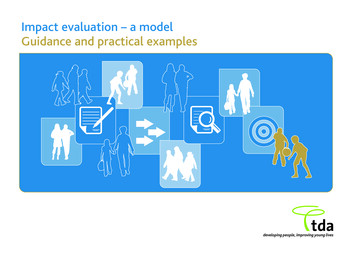
Transcription
Impact evaluation – a modelGuidance and practical examples
2Impact evaluation – a modelThe Training and Development Agency for Schools (TDA) hasdesigned the impact evaluation model to help local authoritiesand schools measure the impact of projects, initiatives and servicesin the areas of workforce reform and extended services.“Home-school support workers and parentsupport advisers are already having ahuge impact. Simply by getting youngpeople into school and keeping themthere we’re improving their learning andseeing real results.”This quote, from an extended services remodellingadviser, is typical of the widespread anecdotalevidence that shows how changes in schools arehaving a positive impact on young people.But although such feedback is valuable andencouraging, there is also a need for more measurableand quantifiable evidence. For policy-makers andthose funding initiatives, ‘hard’ evidence is essential ifthey are to continue to provide funding and support.For those involved in planning and delivery, robustevidence will provide a valuable insight into whatworks best. This information can be used to target andadapt services to deliver the greatest possible impact.The TDA has, therefore, developed an impactevaluation model designed to help local authoritiesand schools bring together qualitative and quantitativeevidence and demonstrate the impact of a wholerange of projects, initiatives and services. This is not anew approach to evaluation – it draws on existinggood practice to create a model that is flexible,practical and user friendly.The first part of this pack provides a brief overview ofthe model, explaining how it works and the benefits itcan offer. It also tells you where to go for moreinformation and support. The second part includes aset of short case studies showing how localauthorities, clusters and schools across England havebeen putting the model into practice and what theyhave learnt along the way.“Many project evaluations are just aboutnumbers and statistics. The impactevaluation model allows you not only tolook at data but also at the real peopleinvolved and at the impact of the projecton communities.”Hilary Fowler, Lead Teacher, Extended Services,North Lincolnshire Council
Impact evaluation – a modelThe impact evaluation modelWhy use the model?How should I use the model?The impact evaluation model is designed to helpyou build up a picture of how you expect a project,initiative or service to work. Working through themodel will clearly demonstrate the links between thevarious stages of service delivery, from planning allthe way through to the impact on individual serviceusers (for example, boosting their confidence andself-esteem) and on the overall project aims (forexample, reducing the number of young people in aparticular area who are not in education, employmentor training). The model is made up of guidance, a setof practical team exercises and ongoing TDA support.Using the impact evaluation model will give you aholistic view of how an intervention is working andwill enable you to build a persuasive case for itsimpact, based on both qualitative and quantitativeevidence. The model can also encourage teammembers to engage more fully in the planning,design and implementation of services, which willboost morale and ensure clarity about project goals.The results will provide a useful resource to drawupon when communicating with stakeholders andservice users.You can use the model alone or as an exercise with agroup of people. Involving a range of people whenbuilding your model will help to build consensus onproject goals but you may find it easier to keep theinitial drafting team relatively small before askingmore stakeholders to get involved.“Using the impact evaluation model reallysimplified the evaluation process for me.It showed me that you don’t need toprove absolutely everything. What youneed to do, and what the model helpsyou do, is build a persuasive case aboutthe impact of your work and how yourinputs lead to your outputs and then toyour outcomes.”Brigid Montgomery, Extended Services Leader,Waltham Forest CouncilWhen should I use the model?The model can be used at any stage of a project but ismost effective when used near the end of theplanning process but before delivery actually begins.By completing the model at this stage, you knowwhat data you need to collect at the outset and anydisagreements in the project team about the aimsof the initiative can be highlighted and resolved atthe start.The model works best when used for any project,initiative or service intended to have a direct impacton children and young people. Note that the model isnot a substitute for good stakeholder engagementand in-depth exploration of the relevant issues – itshould always be used alongside these and other goodchange management practices.“Using the impact evaluation model reallyhelped the governors to articulate andunderstand their accountability for theschool improvement plan and understandhow continuing professionaldevelopment activities can help to meetschool objectives.”Katherine Unwin, Headteacher, Linton FirstSchool, Morpeth3
4Impact evaluation – a modelThe following tips will help you to get the most out ofthe impact evaluation model: Keep it simple – projects may achieve multipleoutcomes but your evaluation should focus onevaluating your key aims only Remember, all evaluation findings make a valuablecontribution to the evidence base, even if theyhighlight areas where the impact was limited. Themodel should not be used to justify a project,initiative or service Evaluate a few things well – it is more practical toevaluate a representative sample than to measureevery activity in which you are engaged Stay focused on how users stand to benefit fromthe project, initiative or service and then considerhow this should contribute to your widercommunity outcomes Be objective Draw on as wide a variety of evidence sourcesas possible Concentrate on creating a persuasive case, not onfinding ‘proof’The impact evaluation model and the self-evaluation formThe Ofsted self-evaluation form (SEF) is an opportunity for schools and their partners to demonstratethe positive impact that workforce reform and extended services are making on the lives on childrenand young people. The impact evaluation model can support this process by helping schools pulltogether evidence that links directly to key areas of the SEF. For instance, evidence showing that pupilsattending a homework club are starting to plan and make decisions about their own learning could beused as an example of how pupils are contributing to the school and wider community. Evidence thatthe school is communicating effectively with parents about the club will help to show that it isengaging with parents and carers.“The way to measure what we do is notalways numeric and there is not enoughtraining for schools around the morequalitative stuff and how we candemonstrate impact. This model providesthat and it really helped me with my SEF.”Marie Corbett, Headteacher, Invicta PrimarySchool, GreenwichFind out moreThe TDA is providing support for local authorities andschools using the impact evaluation model through itsregional delivery partnerships. Contact your TDAregional office for more information. You can alsocontact Piers Hudson from the central TDA team atpiers.hudson@tda.gov.uk“The impact evaluation model has a directand practical value on the ground. Itenables you to focus on what you want toachieve and ensure that the buildingblocks are in place to help you achieve it.”Ian Smith, Extended Services ClusterCoordinator, Plymouth City Council
Impact evaluation – a modelPractical examplesA number of local authorities, clusters and schoolsacross England are using the model to plan and toevaluate aspects of their extended services activities.The following are just some examples. The casestudies are in two parts. The first part looks at: (a) theaims of the specific project, initiative or service andthe reasons for using the impact evaluation model,(b) how the model was used, (c) the lessons learned,(d) next steps for the project and use of the modeland (e) contact details for more information. Thesecond part of each case study is an example of theimpact evaluation model itself. The models shownhere include those developed at various stagesin the project, from initial planning through tofinal evaluation.Local authority modelsParent support adviser induction – DoncasterDisadvantage subsidy pilot – North LincolnshireSexual health drop-in service – PlymouthDisadvantage subsidy pilot evaluation – SuffolkCluster modelsPersonal histories – North LincolnshireEvaluating classes in English as a second language –Waltham ForestPromoting potential – WirralSchool modelsBreakfast club specialising in maths – GreenwichProducing a new school improvement plan –NorthumberlandTransition from primary to secondary school –Redbridge5
6Impact evaluation – a modelParent support advisers – engaging parents in their children’s learningDoncaster MBC, Yorkshire and Humber, ranked 33rd in England for deprivation (2007)PSA induction to the local authority and to schools – June 2009AimsWhat we wanted to do Ensure parent support advisers (PSAs) enter schoolwith a clear understanding of their role and therealisation that they are part of, and supported by,a wider team Ensure schools and agencies understand the PSArole and use PSAs appropriately Use the impact evaluation model (IEM) to measurethe impact of PSAs right from the outset to provethey are a worthwhile investment and todetermine what sort of evidence needs tobe gatheredImpact evaluation – implementationHow we did it Gathered the PSA team together to ensureeveryone could input into the IEM and agree whatwe wanted to achieve Worked through the IEM from the bottom up,starting with the ‘final outcomes’ box Attended TDA regional training day and workedthrough the IEM with a TDA facilitator Arranged half a day’s training to take all PSAsthrough the IEM model so they could start togather evidence for, and prove the impact of, thespecific projects they are runningImpact evaluation – reviewWhat we learnt Working through the IEM from the bottom upenabled us right from the outset to really focus onwhat we wanted to achieve and how we couldprovide evidence of our success Using the IEM makes you aware of differentapproaches and that your colleagues often comeat things from different angles Having a big printout of the IEM and using Post-itsreally helped because it enabled us all to work onthe model at the same time and move the Post-itsaround until we were comfortable about whichboxes to put things in You need to practice using the IEM but it is worththe effortEvidencingimpactNext stepsWhat we will do differently now We want all PSAs to use the IEM to evidence thework they are doing to help ensure they still havejobs in two years’ time We want to share what we are doing widely withinthe council so more people start to use the IEMand see the value it brings“The model takes all your random thoughts andall your colleagues’ random thoughts and helpsyou collate them into a logical process. It givesyou order and helps you match your thoughtsto facts.”Michelle Fitzpatrick, PSA Coordinator, DoncasterMetropolitan Borough CouncilTo find out more about this case study, contactMichelle 302 393915For TDA help and support, contactTessa MasonTDA Yorkshire and Humbertessa.mason@carnegieleaders.org.uk07813 684058
Impact evaluation – a model Inform and promote the PSA role to agencies and schoolsInduct all PSAs using a quality induction processMake PSAs feel part of a team and supportedRaise schools’ awareness of the commitment to parents Number of PSA information sessions run Use of daily evaluation sheet for PSA feedback Feedback from agencies regarding quality ofinformation sessions to measure understanding(survey/questionnaire) More parent-focused in-school delivery Parents consulted on school engagement levels PSA/agencies understand the roleSchools and the local authority (LA) are welcoming, enthusiastic and supportivePeople see PSAs as a worthwhile project to invest inPSAs feel confident, valued and well informed, know they are supported and arepart of the bigger picture PSAs are being employed in schools Percentage positive feedback – PSAs/agencies Number of agencies/PSAs attended as percentage ofthose invited Number of PSAs who attended the info session as apercentage of total number of PSAs Number of PSAs employed against initial target(target 18; PSAs currently employed 23) PSAs have a high profile, feel respected and valued PSAs are working collaboratively as part of a multi-agency team PSAs are seen as integral to the parenting/LA strategy with schools and the LAcommitted to the role Happy PSAs – job satisfaction – stay in post Percentage of schools that want/employ PSAs Increased parental engagement againstinitial benchmark PSAs’ attendance at network meetings PSA named involvement in parenting strategy Agency feedback Headteachers’ survey Six-monthly PSA evaluation Improved staff retention among PSAs compared with similar roles,eg learning mentors PSAs working effectively with families and schools Role is sustainable Percentage of schools that continue to employ PSAsafter 2011 Decrease in PSA staff turnover (as comparison) Improved behaviour, attendance and attainment suchas key stage results, school attendance figures andstrengths/difficulties questionnaire7
8Impact evaluation – a modelExtended services disadvantage subsidy – narrowing the attainment gapNorth Lincs Unitary Authority, Yorkshire and Humber, ranked 86th in England for deprivation (2007)Planning and evaluating the extended services disadvantage subsidy pilot – August 2009AimsWhat we wanted to do Help children to overcome barriers to, and engagein, extended service activities Narrow the gap between advantaged anddisadvantaged children Make more people aware of what activitiesare available Use the impact evaluation model (IEM) to provideevidence of what the extended servicesdisadvantage subsidy funding pilot isactually achieving Use the IEM to focus on what evidence youneed to gather throughout the pilot todemonstrate impactImpact evaluation – implementationHow we did it The extended services remodelling adviser andextended services strategy officer attended a TDAregional event on the IEM. It seemed to offer thesolution to how we should tackle issues aroundmeasuring impact After the event – we were keen to adopt the modelASAP – we worked through the IEM withIntegrated Cluster Coordinator Tim Sullivanand a learning mentor to see how it could beused to plan and evaluate the extended servicesdisadvantage subsidy pilot IEM focused debate on what evidence the teamwould need to gather to evaluate the pilot – Timand learning mentor started to populate the model Worked through the final model with TDA trainerImpact evaluation – reviewWhat we learnt It can be difficult to populate the model whenyou just have a blank template in front ofyou – the TDA can provide a range of simple,worked-through examples and these really help You need to work as a team to ensure clarity oflanguage and terminology It helps to work through the model a few times toclearly understand the logic flow and how it works.It also helps to number each point as you gothrough the model so that you can clearly see thejourney from inputs to outputs to outcomes Keep it simple and don’t think too broadlyEvidencingimpactNext stepsWhat we will do differently now Replicate the IEM across North Lincs Continue to use the IEM as a tool/workingchecklist as we develop the pilot andsubsequent roll-out Link the IEM into our quarterly reporting systemsand our project implementation documents“The extended services disadvantage subsidyhas the potential to improve children’slives. By using the impact model I have beenable to focus my mind on exactly whatevidence I need to look for and to discardthe irrelevant.”Tim Sullivan, Integrated Cluster Coordinator, NorthLincolnshire CouncilTo find out more about this case study, contactTim Sullivantim.sullivan@northlincs.gov.uk07717 58716For TDA help and support, contactTessa MasonTDA Yorkshire and Humbertessa.mason@carnegieleaders.org.uk07813 684058
Impact evaluation – a model Identify and consult target audience re activity providersIdentify schools targeted within defined geographical areaAgree processes, protocols and timescales for the pilotAwareness raising (strategic) – activity providers/LA/communityAwareness raising (operational) – parents/families/participants Eligibility criteria – free schools meals/children incare; consultation results Local knowledge – cluster intelligence/expertise Operational steering group/multi-agency reports reprocesses; minutes re awareness raising/visits/localknowledge/newsletters Target audience identified/engaged; providers identified Schools identified, engaged and proactively involve staff Processes, protocols, sample consultation methods written, agreed and in place(by September 2009) Awareness raised among activity providers/LA/wider community throughpresentations, minutes of meetings, newsletters, web, etc Awareness raised among parents/participants through household mailing, councilnewsletters, summer activities brochure, etc Making parents happier/more confident in the school environment Increasing participation in extended services activities particularly amongtargeted children and their families Enhancing links with other funding streams/initiatives, eg Bridging the Equity Gapand Aiming High for Disabled Children, to help families work together Increasing school’s participation in disadvantage subsidy scheme Attendance at parents’ events; feedback from staffre parents’ attitudes; parental surveys Database; registers; attendance; evaluation sheetsfor children and families Participants logged and tracked by all services Geographical information system used to plotactivity take up School survey of attitudes to the subsidy pilot Raising aspirations for children, their families, schools and the local community Increasing parental engagement of the target group Increasing positive attitudes/decreasing risky behaviour Tracking children to measure attainment/attendance, parental involvement Log attendance parent evenings, family learningsessions, parental feedback survey Activity take-up; adolescent lifestyle/other surveys,eg TellUs; community perception; nationalindicators, eg teenage pregnancyTargeted families response rate re participationApplication and tracking formsAttitudinal surveys (benchmarked)Level of agreement re protocolsList of providers based on consultation resultsMonitored levels and impact of activity in relationto raising awareness9
10Impact evaluation – a modelExtended services – Every Child Matters in actionPlymouth City Council, south-west England, ranked 58th in England for deprivation (2007)Support and information drop-in, including access to sexual health services – October 2009AimsWhat we wanted to do Provide a free support and sexual health drop-inservice – Crownhill Sexual Health Drop-In – ona weekly basis for 13- to 25-year-olds innorth-east/central Plymouth Provide access to sexual health services in relationto the core offer (under swift and easy access) forfive secondary schools and as part of the children’sand young people’s plan – 12-week pilot Trial the use of the TDA’s impact evaluation model(IEM) in evaluating a successful projectImpact evaluation – implementationHow we did it Researched current providers in Plymouth toidentify where their service users livedusing postcodes Carried out a locality needs analysis – identified acommunity youth provider with staff trained insexual health Identified service location – Royal Navycommunity building Set up a meeting between provider,community worker from Royal Navy andextended services coordinator Put in place a partnership agreement Designed leaflets – distributed to schools, GPs,youth outreach workers – and informedschools/school nurses of service Sourced funding – extended services revenuefunding used initially Ran the monitoring data gathered through the IEMto evaluate the project retrospectivelyImpact evaluation – reviewWhat we learnt The service needs to be advertised better throughone-to-one outreach work The service was at the wrong time of day and theentry into the building was wrong (service usersnow enter via the side not the main door) A need for two waiting rooms was identified (theshared-building policy and partnership agreementwas adjusted accordingly) The IEM works best if you do it at the start of theproject so you get a clear idea of what you want toevaluate and the evidence you needEvidencingimpactNext stepsWhat we will do differently now Do more outreach work with young people Change the time of the sexual health service tobefore the Royal Navy Youth Group meets so thatservice users can also attend the youth group Use the IEM across the cluster to plan a varietyof projects“The service is now self-sustainable and nolonger relies on extended services funding,being totally funded instead by health and theyouth service. This really shows the impact ithas had, coupled with the fact that it hasexpanded to other areas.”Mandy Turner, Extended Services Cluster Coordinator,Plymouth City CouncilTo find out more about this case study, contactMandy Turnermandy.turner@plymouth.gov.uk07909 998179For TDA help and support, contactSarah DaviesTDA South Westsarah.davies@southwest-rc.co.uk07853 303951
Impact evaluation – a model Identify target group based on locality needs analysis Identify service that can provide qualified sexual health workers outside ofschool provision Identify partnerships and service location Identify short- and long-term funding Identify local/national research on sexual health and young people Raise awareness of sexual health services, well-being and healthy lifestyles atschools using school nurses/PHSE, etc Local research on locality needs determined locationof new services. Discussions with youth workersascertained the gaps in provision/target audience Local research identified service providers, potentialpartners and funders Information on the new service provision wasprovided to all five secondary schools Target audience identified and consultedPartners identified and on boardService provider on board, location and funding securedThree out of five schools publicised the service (remaining two are RomanCatholic schools) Leaflets/publicity materials designed Local and national research identified and disseminated to relevant partners toinform service provision Consultation with young people Local provision researched and logged Community Links extended services revenue fundingsecured; service level agreements for partners such asyouth service agreed Youth service staff engaged Minutes from quarterly monitoring meetings Flyers/leaflets distributed to GPs, schools, etc Numbers attending – 50 young people accessed theservice leading to 13 pre CAFs, two CAFs and threereferrals to CAMHS Feedback from service users to include where theyheard about/what they think of the service Monitoring to determine viability of pilot service Service gains quality mark/expansion of project fullyfunded to other locationsIncreased awareness of healthy lifestyle choicesIncreased awareness of sexual health and well-beingIncrease in young people making positive choicesDrop-in service successful and promoted positively/increased use of services plusknock-on benefit of young people being engaged in other youth services becauseof its location Improved sexual health/well-being of 13- to 25-year-olds in locality Improved health and lifestyle of 13- to 25-year-olds in locality Reduction in unplanned pregnancies/sexually transmitted infections National indicators re unplanned pregnancies andsexual health11
12Impact evaluation – a modelExtended services disadvantage subsidy – narrowing the attainment gapSuffolk County Council, eastern England, ranked 116th in England for deprivation (2007)Evaluating the disadvantage subsidy pilot – December 2009AimsWhat we wanted to do Pilot the Government’s extended servicesdisadvantage subsidy in two clusters in the county Test two different models of delivering the fundingto see which was the most effective and to informfuture strategy Test the various resources produced for the pilot Use the TDA’s impact evaluation model (IEM) togain an external perspective on how effective thepilot has been and to enable comparison on aregional and national basisImpact evaluation – implementationHow we did it Developed two funding methods for pilot clusters:- in one cluster, 90 per cent of funding wentstraight to schools- in another cluster, 70 per cent of funding wasdevolved to schools but they could only access itafter a plan was produced and spend was verifiedby a steering group Effectiveness of each approach evaluated to informlater roll-out Accessed IEM through the TDA regional trainerafter being alerted to it as part of the disadvantagesubsidy pilot work Created IEM case studies, which are being used toinform strategy development as part of thedisadvantage subsidy roll-outImpact evaluation – reviewWhat we learnt Whole-school approach. Consulting parent supportadvisers, teaching assistants, special educationalneeds coordinators and heads provides a broaderperspective when identifying target group It is much more difficult to get managementinformation from schools when funds have beenallocated directly to them. This can cause issueswhen monitoring the funding and reporting back tothe government office Plan for some admin support. You will need it foreach cluster The IEM may look complicated but, when youwork through it, it is a fairly simple and logicalprocess and it helps you see things you mayotherwise missEvidencingimpactNext stepsWhat we will do differently now Roll out the pilot across all 18 clusters inthe county Use the IEM for external validation and to underpinrecommendations and evaluation findings fromthe pilot to inform a divisional managementteam paper“Headteachers have told me that the subsidyhas enabled them to make a real differenceto the lives of some of their harder-toengage families – massively improving theirrelationships with them.”Paul Nicholls, Extended Services Commissioner,Suffolk County CouncilTo find out more about this case study, contactPaul Nichollspaul.nicholls@suffolk.gov.uk07768 307639For TDA help and support, contactJacqueline McCamphillTDA Eastjacqueline.mccamphill@elc-cambridge.org
Impact evaluation – a model Project implementation document (PID) written to get seniormanagement buy-in Briefing packs produced for schools and local councillors Two cluster launch events held with headteachers to agree target group,protocols, etc (included service providers marketplace) Sent letter inviting all schools and partners to the launches PID; briefing packs; school letter Marketplace attracted 25 service providers fromsports, voluntary sector, etc All 59 schools attended one of the events along withTDA representatives, partners, senior county councilmanagers and elected members Target group agreed and schools engaged with it Steering group formed for each of the two pilot clusters, including headteachersand multi-agency representatives Protocols for spending money agreed with schools plus timescales re funding andtracker sheets agreed to monitor how funds spent Directory of service providers for each cluster produced Own section on the county council website created Elected members/senior managers supportive and engaged Headteachers engage with parents School feedback; steering group minutes; letter toparents (about 50 per cent contacted); tracker sheetsand protocols produced Directory produced and circulated Section on county council website launched forone cluster Greater attendance and fewer exclusions. Target group confidence/self-esteem improved Increased participation of target group in activities Social capital built with parents now actively engaged with schools Greater multi-agency awareness of subsidy and better planning at cluster level –although some tensions between schools and partners re what activities somestudents should be offered Flexible funding enabled heads to target better/increase trust Activity attendance log School attendance for some increased from 50 percent to 95 per cent thanks to breakfast club Exclusions down among key groups Nurture group improved behaviour/attendance. Onechild improved five sub reading levels in year More cluster planning for multi-agency events Case studies, anecdotal feedback, parents’ letters,more parents engaged with the schools Sustainability – increased parental and multi-agency involvement releasesresources elsewhere Improved attainment among target audience – narrowing the attainment gap andimproving behaviour School feedback re behaviour/attainmentimprovement; will use key stage/GCSE results Greater range of activities from more staff time Use of SOUL (soft outcome universal learning) tomeasure self-esteem, etc13
14Impact evaluation – a modelExtended services – Every Child Matters in actionNorth Lincs Unitary Authority, Yorks and Humber; ranked 86th in England for deprivation (2007)Personal histories: a celebration of childhood memories – October 2009AimsWhat we wanted to do Take an existing pilot and adapt it locally topromote intergenerational understanding andcommunity cohesion Enable practitioners, through a creative curriculum,to engage children, young people, their familiesand the wider community Use the impact evaluation model (IEM) todetermine and then demonstrate the impactof the
6 Impact evaluation - a model Parent support advisers - engaging parents in their children's learning Doncaster MBC, Yorkshire and Humber, ranked 33rd in England for deprivation (2007)

